



Last updated March 2021
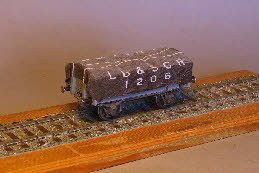
 Here are the four D2’s in various guises. On the left is a wagon painted in the early pale grey ‘illiterate’ livery, weathered to look old and worn. It is loaded with clay pipes (made from brass tube), and packed with straw (plumber's hemp) to prevent breakage in transit. It was made for use with Plumpton Brick and Tile works.
Here are the four D2’s in various guises. On the left is a wagon painted in the early pale grey ‘illiterate’ livery, weathered to look old and worn. It is loaded with clay pipes (made from brass tube), and packed with straw (plumber's hemp) to prevent breakage in transit. It was made for use with Plumpton Brick and Tile works.
On the right is another wagon, also in pale grey livery, covered with a (Smith’s) tarpaulin.
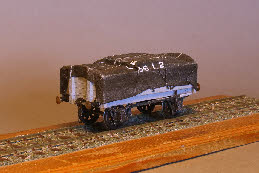
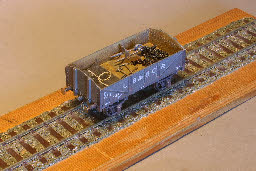 On the left is a wagon with a home-
On the left is a wagon with a home-made tarpaulin. The boltheads on this wagon were made by applying dots of epoxy resin on the end of a piece of wire. I don’t think this technique was particularly successful, and the experiment wasn’t repeated.
The wagon on the right was made to be part of the Cowans and Sheldon crane train, and contains various bits and pieces related to permanent way maintenance.
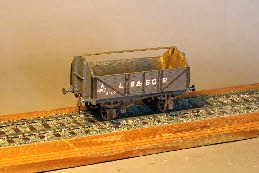
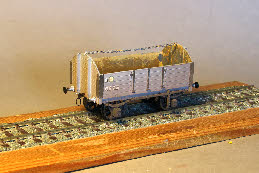 These are the four type A wagons. On the left is an early wagon with a chain to support the tarpaulin, and a single iron brake shoe.
These are the four type A wagons. On the left is an early wagon with a chain to support the tarpaulin, and a single iron brake shoe.
On the right is a later version in the mid-period livery, with a solid wooden bar for the tarpaulin, and a single wooden brake block.
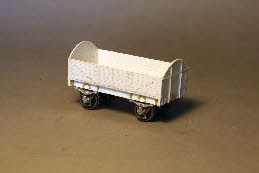
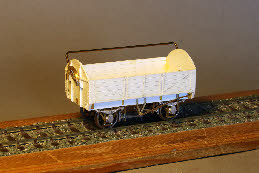 The last two wagons are shown unfinished. The wagon on the left is fitted with the later ‘hi-
The last two wagons are shown unfinished. The wagon on the left is fitted with the later ‘hi-bar’, and single-sided double block brakes. The metal-work on the sole bar is part of the EBM etch for the W-irons, but the buffer backing plates were cut out on the Silhouette cutter
To the right, this vehicle will be fitted with the same type of brakes, but without a tarpaulin rail.

 Here are the four D2’s in various guises. On the left is a wagon painted in the early pale grey ‘illiterate’ livery, weathered to look old and worn. It is loaded with clay pipes (made from brass tube), and packed with straw (plumber's hemp) to prevent breakage in transit. It was made for use with Plumpton Brick and Tile works.
Here are the four D2’s in various guises. On the left is a wagon painted in the early pale grey ‘illiterate’ livery, weathered to look old and worn. It is loaded with clay pipes (made from brass tube), and packed with straw (plumber's hemp) to prevent breakage in transit. It was made for use with Plumpton Brick and Tile works.On the right is another wagon, also in pale grey livery, covered with a (Smith’s) tarpaulin.

 On the left is a wagon with a home-
On the left is a wagon with a home-The wagon on the right was made to be part of the Cowans and Sheldon crane train, and contains various bits and pieces related to permanent way maintenance.

 These are the four type A wagons. On the left is an early wagon with a chain to support the tarpaulin, and a single iron brake shoe.
These are the four type A wagons. On the left is an early wagon with a chain to support the tarpaulin, and a single iron brake shoe. On the right is a later version in the mid-

 The last two wagons are shown unfinished. The wagon on the left is fitted with the later ‘hi-
The last two wagons are shown unfinished. The wagon on the left is fitted with the later ‘hi-To the right, this vehicle will be fitted with the same type of brakes, but without a tarpaulin rail.